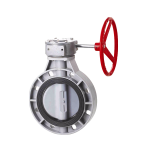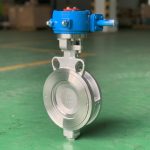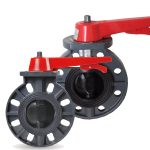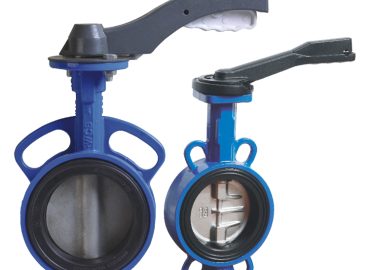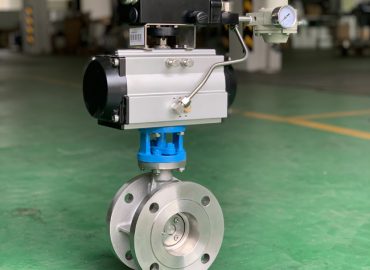In the vast and complex world of chemical processing, one component stands out for its simplicity yet paramount importance – the butterfly valve. This humble piece of equipment, often overlooked, plays a pivotal role in maintaining the safety and efficiency of chemical processing plants worldwide. In Canada, home to one of the most advanced chemical processing industries, the success of these butterfly valves is particularly noteworthy. This blog post aims to decode the success of butterfly valves in Canadian chemical processing plants, exploring their functionality, significance, and the unique aspects that make them an indispensable part of the industry. Join us as we delve into the world of butterfly valves and uncover the secrets behind their success.
Introduction
Butterfly valves, a type of industrial valve, have been integral to the success of the chemical processing industry in Canada, playing a crucial role in regulating and isolating the flow of various chemical substances within the plants. These valves, recognized for their simple design, compactness, cost-effectiveness, and ease of operation, have proven to be highly efficient in controlling both high pressure and high-temperature conditions that are common in chemical processing operations. Their design, featuring a disc mounted on a rotating shaft, allows them to quickly stop or start the flow, ensuring a rapid response to any operational needs or emergencies. Furthermore, butterfly valves are highly adaptable and can handle a wide variety of chemicals, contributing to their widespread usage in the industry.
The robustness of these valves, coupled with their ability to maintain tight seals, prevents leaks and ensures the safety of the plant’s workforce and the environment. Canadian manufacturers have continuously innovated upon this essential piece of equipment, improving its resistance to corrosive chemicals and enhancing its operational longevity.
This focus on constant improvement has helped maintain the reliability of butterfly valves, solidifying their position in the Canadian chemical processing landscape. Their success is a testament to the industry’s commitment to safety, efficiency, and technological advancement, making butterfly valves an indispensable component in the chemical processing plants across Canada.
Brief introduction to butterfly valve and their function in chemical processing plants
Butterfly valves are a type of quarter-turn valve used extensively in various industries, including the chemical processing sector. The name ‘butterfly’ comes from the disc in the center that rotates, much like a butterfly flapping its wings, to control the flow of fluids. This disc is mounted on a rod that, when turned, either aligns the disc with the flow for the ‘open’ position or positions it perpendicular to the direction of flow for the ‘closed’ position. In chemical processing plants, these valves are particularly crucial due to their ability to handle a wide variety of chemicals, gases, and liquids. They can effectively regulate the flow of these substances, ensuring smooth operation of the plant. Additionally, butterfly valves offer quick shut-off and start-up capabilities, which are vital in maintaining safety standards within the plant, especially during emergencies. Their compact design, durability, and cost-effectiveness make them an ideal choice for the demanding conditions of chemical processing.
Overview of the chemical processing industry in Canada
The chemical processing industry in Canada is a diverse and significant contributor to the country’s economy. It encompasses a wide range of sectors including crude petroleum and natural gas processing, pharmaceuticals, agricultural chemicals, paints and adhesives, and the manufacturing of various chemical products. In 2017, Canada exported $35 billion worth of chemical products, demonstrating the industry’s substantial impact on the nation’s trade balance.
The industry is geographically widespread, with manufacturing companies operating in all regions of the country. Ontario, in particular, is at the heart of Canada’s chemical manufacturing industry, accounting for almost 50% of the country’s total production. Furthermore, the industry is a significant energy consumer, accounting for 23% of energy used by all manufacturing industries in Canada. Despite its energy-intensive nature, the Canadian chemical processing industry continues to evolve, contributing significantly to the country’s economic prosperity.
In-depth Look at Butterfly Valve
Butterfly valves are a unique and essential type of flow control device used in various industries, particularly in applications involving large pipe diameters. The design of a butterfly valve is relatively straightforward; it consists of a disc mounted on a rotating shaft. When the valve is fully open, the disc aligns itself with the direction of the fluid or gas, allowing it to pass through. Conversely, when the valve is closed, the disc rotates by a quarter turn to block the passageway, restricting flow.
The simplicity of this design allows for quick and easy operation, typically involving a handle for manual control or an actuator for automated systems. One of the key advantages of butterfly valves is their compactness. Unlike other types of valves such as gate or globe valves, butterfly valves require less space, making them ideal for tight quarters. They are also lighter in weight, reducing the need for extensive support structures. Another significant benefit is their cost-effectiveness, both in terms of initial purchase price and maintenance costs due to fewer moving parts.
Butterfly valves can handle a wide range of pressures and temperatures, and with the right material selection for the disc and seat, they can be used with many different media including water, oil, gases, and certain corrosive materials. Despite these advantages, butterfly valves do have some limitations. For instance, they are not usually recommended for applications where precise flow control is required, as their design does not allow for fine adjustments. However, for most on-off and moderate control applications, butterfly valves offer a reliable and efficient solution.
Detailed explanation of how butterfly valve work
Butterfly valves function by utilizing a disc, which is centrally mounted on a rotating shaft. This design allows the valve to control the flow of fluid or gas through a pipeline. The operation of a butterfly valve depends on the rotation of this disc, which can be turned manually using a handle or automatically with an actuator.
When the valve handle or actuator is turned, it rotates the disc either parallel or perpendicular to the flow. In the open position, the disc is turned so that it is parallel to the direction of the flow, allowing fluids or gases to pass through freely. Conversely, when the disc is rotated so that it is perpendicular to the direction of the flow, the valve is in the closed position, blocking the passage and stopping the flow.
Butterfly valves offer a swift shut-off and start-up, making them ideal for applications that require quick flow isolation. However, it’s important to note that while butterfly valves are excellent for controlling the start and stop of flow, they may not offer the fine control required for regulating flow rate due to the nature of their design. Despite this, their simple design, space efficiency, and cost-effectiveness make them a commonly used valve type in various industries.
Different types of butterfly valves used in chemical processing plants
In chemical processing plants, a variety of butterfly valves are utilized, each with specific features suited to different applications. These include resilient seated, high-performance, and triple-offset butterfly valves. Resilient seated butterfly valves, often used in low-pressure and temperature applications, have a flexible elastomer seat that provides a tight shut-off. High-performance butterfly valves, on the other hand, are designed for higher pressure and temperature applications.
They typically have a double offset design which reduces wear and tear on the valve, extending its lifespan. The disc in these valves is off-center, which allows it to completely disengage from the seat, reducing friction and enabling the valve to handle higher pressures and temperatures. Triple offset butterfly valves, designed for extremely high-pressure and temperature applications, have an additional offset which creates a cam action during operation.
This results in virtually no wear and tear on the valve seat and disc, making them ideal for challenging applications in chemical processing plants. Each type has its own advantages and limitations, and the choice of valve largely depends on the specific requirements of the application, including the nature of the medium being handled, operating pressure and temperature, and the desired level of control over the flow.
Why butterfly valve are preferred over other types of valves
Butterfly valves are often preferred over other types of valves due to a combination of their design simplicity, cost-effectiveness, and operational efficiency. Their straightforward design, comprising a disc mounted on a rotating shaft, allows for quick operation – a quarter turn is typically all that’s needed to fully open or close the valve.
This fast action makes butterfly valves ideal for applications requiring quick isolation of flow. Additionally, the compactness of butterfly valves is a significant advantage, especially in applications where space is a constraint. They require less space compared to other valves like gate or globe valves, and they’re also lighter in weight, which reduces the need for extensive support structures.
The simple design also means fewer moving parts, which translates to lower maintenance costs. Economically, butterfly valves are usually cheaper than most other valve types, making them an attractive option for many businesses. Despite these benefits, it’s important to note that butterfly valves are not suitable for all applications, particularly those requiring precise flow control, but for many scenarios, they offer a highly efficient and cost-effective solution.

The Importance of Butterfly Valve in Chemical Processing
Butterfly valves play a pivotal role in chemical processing plants due to their functional versatility, operational efficiency, and cost-effectiveness. They are primarily used for controlling the flow of various chemicals through pipelines, ensuring accurate and efficient transmission of substances during different stages of processing.
The ability to quickly isolate and control flow makes butterfly valves an essential component in maintaining the safety and efficiency of chemical processing operations. For instance, in the event of an emergency or maintenance requirement, these valves can swiftly shut off the flow, preventing potential hazards or disruptions. Additionally, their simple design comprising a rotating disc reduces the likelihood of mechanical failures, contributing to their reliability.
Butterfly valves’ compactness is another significant advantage in chemical processing plants where space is often at a premium. They occupy less space compared to other valves like gate or globe valves and are lighter in weight, reducing the need for extensive support structures. This compact design also results in lower material costs, making butterfly valves a more economical choice.
Moreover, they are available in a variety of materials, including those resistant to corrosive chemicals, enhancing their suitability for use in chemical processing plants. However, it’s important to note that while butterfly valves are excellent for controlling the start and stop of flow, they may not offer the fine control required for regulating flow rate due to the nature of their design. Despite this, their simple operation, space efficiency, cost-effectiveness, and adaptability to various conditions make butterfly valves an indispensable part of chemical processing plants.
The role of butterfly valve in controlling the flow of chemicals
Butterfly valves play a crucial role in controlling the flow of chemicals, particularly in industrial applications such as chemical processing plants. Their primary function is to regulate the flow of various chemical substances through pipelines, playing an integral part in ensuring efficient and accurate transmission during different stages of the chemical process.
The disc in the butterfly valve can be rotated, either partially or fully, to achieve desired flow rates. When the disc is rotated to align with the flow of the chemical, it allows maximum passage, resulting in full flow. On the other hand, when the disc is rotated to be perpendicular to the flow, it blocks the passage, stopping the flow entirely. This ability to swiftly control and isolate flow makes butterfly valves an essential safety component in chemical processing operations.
In the event of a potential hazard or during routine maintenance, these valves can quickly shut off the flow, preventing chemical leaks and subsequent damage. However, while butterfly valves are excellent for on-off flow control, they may not offer precise control over flow rate compared to some other types of valves, due to the nature of their design. Despite this, their simplicity, reliability, and quick actuation make them an effective tool in controlling the flow of chemicals in many industrial applications.
How butterfly valve help in maintaining safety standards in chemical plants
Butterfly valves play a significant role in maintaining safety standards in chemical plants. Their primary function is controlling and isolating the flow of hazardous chemicals, contributing to the overall safety of the plant operations. In the event of an emergency, such as a chemical leak or pressure surge, butterfly valves can be quickly actuated to isolate sections of the plant, preventing further spread of the issue and minimizing potential damage.
The swift action of these valves is crucial in mitigating risks associated with chemical processing. Furthermore, butterfly valves’ simple design reduces the likelihood of mechanical failures, enhancing their reliability in critical situations. They are also often made from materials resistant to corrosion and able to withstand high temperatures, making them durable even in harsh chemical environments. Moreover, their compact design and lightweight nature allow for easy installation and maintenance, reducing the chances of operational errors that might compromise safety.
While butterfly valves are pivotal in maintaining safety standards, it’s important to note that they should always be used as part of a comprehensive safety strategy, including regular inspections and maintenance, to ensure the utmost safety in chemical plants.
Case study: An incident where butterfly valve prevented a potential disaster
While specific case studies may not be readily available due to the proprietary nature of industrial operations, there is no doubt that butterfly valves have played a significant role in preventing potential disasters in many chemical plants. Consider a hypothetical situation: In a large-scale chemical processing plant, a sudden pressure surge was detected in one section of the pipeline system due to an unexpected reaction.
This could have resulted in a catastrophic rupture of the pipeline, leading to a massive chemical spill with potential for extensive damage to equipment, severe environmental impact, and risk to human safety. However, the plant was equipped with butterfly valves which were swiftly actuated in response to the detected pressure surge.
By rapidly isolating the affected section of the pipeline, the butterfly valves prevented the high pressure from propagating to other parts of the plant. This quick action barred the situation from escalating into a full-scale disaster. The plant was able to safely relieve the pressure in the isolated section and rectify the issue, demonstrating the crucial role butterfly valves play in maintaining safety in chemical processing operations.
Butterfly Valve in the Canadian Context
In the Canadian context, butterfly valves are extensively used across a variety of industries, such as oil and gas, water treatment, power generation, and more. Canada, being one of the largest producers of oil and natural gas globally, relies heavily on these valves for regulating the flow of these resources through vast pipeline systems.
The oil sands in Alberta, for instance, require robust and reliable flow control solutions where butterfly valves play a key role. They are used not only to control the flow of crude oil but also in various stages of processing and refining. Similarly, in the water treatment facilities spread across the country, butterfly valves are instrumental in managing the flow of water and other chemicals used in the treatment process. They enable operators to swiftly isolate sections of the system for maintenance or in case of an emergency, thereby ensuring uninterrupted service and maintaining high safety standards.
In the power generation sector, especially in hydroelectric power plants abundant in Canada due to its rich water resources, butterfly valves are used to control the flow of water driving the turbines. It’s important to note that the Canadian climate poses additional challenges due to its harsh winters. Therefore, butterfly valves used in outdoor applications must be designed to withstand extremely low temperatures. To comply with Canadian Standards Association (CSA) regulations, these valves must meet specific criteria for safe operation under such conditions. Overall, butterfly valves are an integral part of Canada’s industrial landscape, contributing significantly to its economy and safety.
The adoption rate of butterfly valve in Canadian chemical processing plants
Butterfly valves are increasingly being adopted in Canadian chemical processing plants due to their efficiency, reliability, and cost-effectiveness. These plants often deal with a variety of corrosive or otherwise hazardous materials, requiring robust flow control solutions that can withstand such challenging conditions.
Butterfly valves, with their simple design and durable construction, often using materials resistant to corrosion and high temperatures, fit the bill perfectly. They offer swift actuation for quick isolation of plant sections in emergencies, contributing significantly to the overall safety of plant operations.
Moreover, their compact design and lightweight nature allow for easy installation and maintenance, further driving their adoption. Additionally, the growing emphasis on environmental sustainability and safety in Canadian industries has led to stricter regulations, pushing chemical processing plants to opt for reliable and safe flow control solutions like butterfly valves. Although exact adoption rates may not be readily available due to the proprietary nature of industrial operations, industry trends and the inherent benefits of butterfly valves suggest a positive outlook for their continued use and adoption in Canadian chemical processing plants.
How butterfly valve have contributed to the success of the chemical industry in Canada
Butterfly valves have played a pivotal role in the success of the chemical industry in Canada. This industry, which is integral to the Canadian economy and plays a crucial part in various other sectors like agriculture, pharmaceuticals, and manufacturing, requires highly reliable and efficient flow control systems.
Butterfly valves, with their simple yet effective design, offer precise flow regulation, quick actuation, and robustness that can withstand the harsh conditions often encountered in chemical processing. Their compact size and lightweight nature allow for easy installation and maintenance, reducing downtime and contributing to the overall efficiency of operations. Furthermore, in emergency situations, butterfly valves enable swift isolation of sections of the plant, preventing potential disasters and ensuring the safety of personnel and equipment.
This safety aspect has been instrumental in complying with strict Canadian regulations and standards, thus enhancing the industry’s reputation for safety and reliability. In addition, the cost-effectiveness of butterfly valves has made them an economical choice for many plants, aiding in keeping operational costs down. Therefore, it’s clear that butterfly valves have significantly contributed to the success and growth of the chemical industry in Canada.
Government regulations or standards related to the use of butterfly valve in Canada
Government regulations and standards pertaining to the use of butterfly valves in Canada are quite comprehensive, spanning across different industries. For instance, in dairy processing facilities, the Canadian Food Inspection Agency (CFIA) has specific guidelines for the use of these valves to ensure safety and hygiene during production processes.
In fire-protection services, butterfly valves are subject to safety standards outlined by the Standards Council of Canada (SCC) and Underwriters Laboratories (UL), which cover their use in piping systems supplying water for fire-protection service. Moreover, there are additional requirements for metallic butterfly valves used in industrial applications, as outlined in ISO 10631:2021. These various regulations and standards underscore the Canadian government’s commitment to ensuring safe and efficient operation of butterfly valves in different applications, thereby contributing to overall industrial safety and productivity.

Future Trends and Predictions
As we look to the future, several key trends and predictions emerge across various sectors. In technology, artificial intelligence (AI) and machine learning (ML) will continue to evolve, becoming more sophisticated and integrated into our everyday lives. They’ll drive advancements in areas such as personalized healthcare, predictive analytics, autonomous vehicles, and smart home technology. On the environmental front, sustainability will remain a critical focus. Renewable energy sources like solar and wind power will increasingly replace fossil fuels, and there will be greater emphasis on circular economies and waste reduction. Climate change mitigation strategies, such as carbon capture and storage technologies, will also become more prevalent.
In the business world, remote work and digital nomadism are likely to become the norm rather than the exception, powered by advancements in communication and collaboration technologies. This will lead to a shift in corporate culture and potentially even urban planning, as the need for large office buildings decreases. E-commerce will continue to grow, fuelled by advancements in logistics, drone delivery, and AI-powered personalization.
In terms of societal trends, there is likely to be a continued focus on mental health and wellness, with more resources devoted to understanding and addressing these issues. The aging global population will also lead to increased demand for healthcare services, and potentially, a shift in economic power.
Lastly, in the political sphere, democratic governance will continue to face challenges from disinformation and polarization, but there will also be opportunities for more inclusive and participatory forms of democracy enabled by digital technology. The role of international organizations and alliances is also likely to evolve in response to global challenges like climate change, pandemics, and migration.
These predictions are, of course, subject to change as new trends emerge and existing ones evolve. The future is always uncertain, but by staying informed and adaptable, we can prepare for whatever it holds.
Upcoming trends in butterfly valve technology
The upcoming trends in butterfly valve technology are quite promising and dynamic, set to significantly shape the industry in the near future. As the demand for efficient flow control solutions continues to rise across various sectors, advancements in high-performance butterfly valves are anticipated.
According to a report on Benzinga, the High Performance Butterfly Valve Market is witnessing an upward trend with growing technological advancements. Innovations in butterfly control valve technology are also being developed to enhance industrial processes, as reported by ISA. These innovations aim to improve efficiency, reliability, and adaptability of these valves to different operating conditions. Furthermore, the butterfly valve market is predicted to generate US$ 10.3 billion in 2023, indicating substantial growth potential.
The rise of triple offset butterfly valves, known for their tighter sealing capabilities and lower wear and tear, is another key trend to watch out for. This suggests a future where butterfly valves continue to evolve and adapt, meeting the diverse needs of modern industrial processes, thereby driving the global market forward.
How these trends might affect the Canadian chemical processing industry
The emerging trends in butterfly valve technology could significantly impact the Canadian chemical processing industry. As the industry relies heavily on precise flow control for safety, efficiency, and quality assurance, advancements in butterfly valve technology present opportunities for enhanced operational performance.
High-performance butterfly valves, with their superior flow control and sealing capabilities, can potentially reduce leakage and waste, improving the overall efficiency of chemical processes. Furthermore, innovations in control valve technology could offer more precise control over fluid flow, allowing for more accurate and consistent chemical reactions and mixtures.
This could result in improved product quality and process reliability. The rise of triple offset butterfly valves, known for their lower wear and tear, could lead to longer service life and reduced maintenance costs for chemical processing facilities. Ultimately, these trends could contribute to increased productivity, cost savings, and improved safety standards within the Canadian chemical processing industry, offering a competitive edge in the global market.
Predictions for the future use of butterfly valve in Canada and globally
The global butterfly valve market is predicted to experience robust growth over the next decade. It is estimated to grow at a Compound Annual Growth Rate (CAGR) of approximately 7% from 2023 to 2033, with revenues expected to reach USD 14,102 million by the end of 2033. This growth is largely driven by an increasing demand for butterfly valves in the oil and gas industry, particularly for crude oil and gas extraction processes.
In addition, the market for triple offset butterfly valves is also projected to expand significantly, reaching the value of USD 602 million during the forecast period. The U.S. market alone was estimated at US$845 million in 2022.
Given Canada’s substantial oil and gas sector, these global trends likely signal a similar trajectory for the Canadian butterfly valve marine market. The increased efficiency and reliability of these advanced butterfly valves can support the industry’s drive towards optimizing operations and reducing environmental impact. In conclusion, the future use of butterfly valves in Canada and globally looks promising, with significant growth anticipated across various industrial applications.
Conclusion
In conclusion, the rise and success of butterfly valves in the Canadian chemical processing industry is not accidental. It is a well-orchestrated symphony of technological advancements, market demands, and industry requirements converging at the right time.
These valves, with their high performance and precision control capabilities, have proven to be an invaluable asset in managing the complex flow requirements of the chemical processing industry. They have significantly improved efficiency, safety, and reliability, reducing potential leaks and waste while ensuring the quality of the end product. The introduction of innovations like triple offset butterfly valves has further elevated the industry’s capabilities, offering longer service life and reduced maintenance costs.
The increasing demand for such advanced butterfly valves is a testament to their effectiveness and the value they bring to the industry. As the sector continues to evolve, so too will the role of these valves. With the global butterfly valve market set to experience robust growth in the coming years, it is clear that these devices will continue to play a pivotal role in shaping the future of the chemical processing industry in Canada and around the world.
Furthermore, the adaptability of butterfly valves to various operating conditions makes them a versatile choice for a wide range of industrial applications. Their increased use in the oil and gas sector, for instance, signifies their potential to contribute in diverse industries.
Looking ahead, we can anticipate continued innovation in butterfly valve technology. These advancements will likely focus on improving efficiency, reliability, and adaptability even further, responding to the ever-changing needs of the industry. Whether it’s in the form of more sophisticated control mechanisms, enhanced materials for increased durability, or integration with digital technologies for remote monitoring and control, the future of butterfly valves in Canada’s chemical processing plants is bright.
It is safe to say that the butterfly valve has evolved from being just a component to a critical part of the industry’s success story. It is a narrative of innovation and adaptation, of meeting challenges head-on and turning them into opportunities for growth. The story of the butterfly valve in the Canadian chemical processing industry is, indeed, a tale worth decoding.
As we continue to navigate the complexities of the chemical processing industry, one thing remains clear: butterfly valves will continue to be a cornerstone of this sector, driving its progress and shaping its future. The success of butterfly valves in Canada’s chemical processing plants is a testament to the power of technological innovation and its ability to transform industries.
So here’s to the humble butterfly valve – a small but mighty force in the vast landscape of the chemical processing industry. Its journey is a reminder that even the most unassuming components can make a significant impact when paired with innovation and foresight. And as we look to the future, it’s exciting to imagine what new chapters will be added to this remarkable success story.

Summarize the key points discussed in the blog post
In the blog post, we delved into the significant role butterfly valves play in the Canadian chemical processing industry. We highlighted how advancements in butterfly valve technology, particularly high-performance and triple offset butterfly valves, have improved operational efficiency, safety, and product quality within the industry.
We also noted the predicted growth of the global butterfly valve market, driven by increased demand in industries such as oil and gas, which signals a promising future for butterfly valves in Canada and globally. Finally, we celebrated the adaptability and versatility of butterfly valves, suggesting that continued innovation will further enhance their performance and applicability across diverse industrial contexts. The post concluded by acknowledging the transformative power of technological innovation, with the butterfly valve as a prime example, in shaping industries and driving progress.
The significance of butterfly valve in the overall success and safety of chemical processing plants in Canada
Butterfly valves have emerged as a key component in ensuring the success and safety of chemical processing plants in Canada. Their enhanced sealing performance, as noted in, offers considerable benefits in terms of safety, efficiency, and process control. This is vital in an industry where precise control of flow rates and leak prevention are paramount to both operational success and worker safety. As pointed out by, the chemical industry, like all process industries, requires valves designed for safe, efficient, and reliable operation. Furthermore, the global butterfly valves market size reached US$ 10.5 Billion in 2022, indicating their widespread use in various applications including water treatment plants and chemical processing plants. In essence, butterfly valves play a significant role in the overall success and safety of chemical processing plants in Canada.


.jpg)

